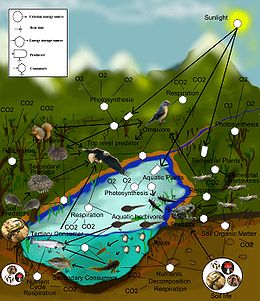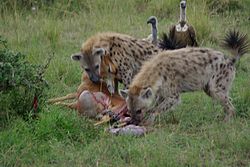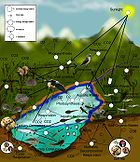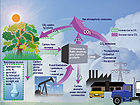- Consumer (food chain)
-
Consumers are organisms of an ecological food chain that receive their energy by consuming other organisms. These organisms are formally referred to as heterotrophs, which includes animals, bacteria and fungus.
Contents
Classification
Consumers are typically viewed as predatory animals such as the wolf and hyena. However, herbivorous animals and parasitic fungus can also be consumers. Some carnivorous plants, like the Venus flytrap, exhibit both characteristics of a consumer and producer and therefore can be classified as both.[1]
Levels
 A food web showing the organisms and their trophic levels.
A food web showing the organisms and their trophic levels. Main article: Trophic level
Main article: Trophic levelWithin an ecological food chain, consumers are categorized into three groups: primary consumers, secondary consumers, and the tertiary consumers.[2] Primary consumers are usually herbivores, feeding on plants and fungus. Secondary consumers, on the other hand, are mainly carnivorous and prey other animals. Omnivores, who feed on both plants and animals, can also be considered as a secondary consumer. Tertiary consumers, sometimes also known as an apex predator, are usually on top of a food chain, capable of feeding on secondary consumers and primary consumers. Tertiary consumers can be either fully carnivorous or omnivorous. Humans are one such example of a tertiary consumer.
Importance to the ecosystem
Consumers dominate most of a food chain. Consumers have important roles to play within an ecosystem such as balancing the food chain by keeping animal populations at a reasonable number. Without proper balance, an ecosystem can collapse and cause the decline of all affected species.
See also
References
Categories:- Trophic ecology
Wikimedia Foundation. 2010.



